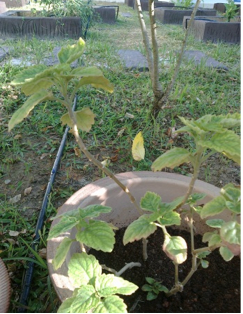Nilam
| Nilam | |
| Scientific Name | Pogostemon cablin (Blanco)benth |
| Family | Labiatae/lamiacea |
| Synonyms | Pogostemon patchouli |
| Common Name | Patchouli, patchouly, pachouli |
 |
{slider=Geographical Distributions}
Native to tropical regions of Asia and extensively cultivated in Malaysia, Indonesia, Thailant, Vietnam, Philippines, Taiwan, Cina, Mauritius and West Africa.
{/slider}
{slider=Cultivation}
Patchouli grows well in warm to tropical climates. It thrives in hot wather, but not direct sunlight. Propagation with seed or stem can be rooted in water(7)
{/slider}
{slider=General Appearances}
Bushy her with erect stems, reaching two or three feet in hight and bearing small, pale pink-white flowers.
{/slider}
{slider=Plant Material of Interest}
The plant are cultivated foe their oils. The patchouli oil obtained by steam distillation is an important natural material in the perfumery and food industry and used to repel insect. Volatile composition of P. cablin obtained by steam distillation was extensively studied but non-volatile composition was not (7).
The accumulation of sesquiterpenes, not only in the external glandular trichomes, but also in specialized internal accumulatory cells. The second pair of primordial leaves has glandular trichomes and a sesquiterpene concentration approximately twelve times higher than that in any other part of the plant (Hederson W. et al 1970)
{/slider}
{slider=Chemical Contents}
Patchouli alcohol, pogostone, eugenol, α-bulnesene, rosmarinic acid. Essential oils constitute about 1.5% of P. cablin and among them >50% is patchouli alcohol. Alkaloid. Flavanoid: ombuine, pachypodol, kumatakenin. Other compounds are 7,4’-di-O-methyleriodictyol, and 3,7, 4’-tri-O-methylkaempferol and 7,3’,4’-tri-O-methyleriodictyol. Sesquiterpene cyclase, patchoulol synthase purified from leave (Munck S.L. & R. Croteau 1990).
α-Bulnesene is a sesquiterpenoid isolate from water extract of P. cablin (Hsu H.C. et al 2006).
{/slider}
{slider=Traditional Uses}
Aerial part of Pogostemon cablin has been used against the common cold an as antifungal agent. In Korea, water extract of P. cablin was used for the treatment of fever caused by heart stroke, poor appetite, nausea, etc. Water extract was used for the treatment of apoplexy for a long time; however, the target site and mechanism responsible for the clinical efficacies are not clear yet.
{/slider}
{slider=Pharmacology}
ROS Scavanger
Pogostemon cablin significantly prevented H2O2-induced release of cytochrome c into cytosol. Determination of intracellular ROS showed that Pogostemon cablin might exert its role as a powerful scavenger of intracellular ROS. The present study suggests the beneficial effect of Pogostemon cablin on ROS-induced neuroglial cell injury (Kim H.W. et al 2008) Vital energy and eliminating phlegm. Cerebral stoke (Kim H.W. et al 2008).
Anti-emetic
N –hexane extract of P. cablin, Patchouli alcohol, pogostol, stigmast-4-en-3-one, retusin and pachypodol were tested and exhibited anti-emetic effects (Yang Y. et al 1999)
Inhibitory effect on platelet-activating factor (PAF) & arachidonic acid induced rabbit platelet aggregation.
In a radioligand binding assay for the PAF receptor, α-bulnesene competitively inhibited [3H]PAF binding to the PAF receptor with an IC50 value of 17.62 ± 5.68 μM. α-Bulnesene also dose-dependently inhibited PAF-induced intracellular Ca2+ increase in fluo-3/AM-loaded platelets (IC50 values of 19.62 ± 1.32 μM). Furthermore, α-bulnesene inhibited AA-induced thromboxane B2 (TXB2) formation and prostaglandin E2 (PGE2) formation. These results indicate that the inhibitory effect of α-bulnesene on platelet aggregation was due to a dual activity; specifically the chemical blocked PAF-induced intracellular signal transduction and interfered with cyclooxygenase activity, which resulted in a decrease in thromboxane formation. This study is the first to demonstrate that α-bulnesene is a PAF receptor antagonist as well as an anti-platelet aggregation agent ( Hsu H.C. et al 2006){/slider}
{slider=Toxicity}
A methanol extract from P. cablin showed a suppression effect on umu gene expression of SOS response in Salmonella typhimurium TA153/pSK1002 against the mutagen 2-(2-furyl)-3-(5-nitro-2-furyl)acrylamide (furylfuramide). The methanol extract was re-extracted with dichloromethane showed a suppressive effect. Compound 7,4’-di-O-methyleriodictyol, and 3,7, 4’-tri-O-methylkaempferol suppressed > 50 % of the SOS-inducing activity at <0.6 umol/mL, and the ID50 values of both compounds were 0.25 umol/mL. Compund 7,3’,4’-tri-O-methyleriodictyol showed a weakly suppressive effect (17%) at a concentration of 0.6 umol/mL (Miyazawa M., et al 2000)
{/slider}
{slider=Reference}
Hederson W., W.H. James & P. How, J. Judge (1970). Chemical and morphological studies on sites of sesquiterpene accumulation in Pogostemon cablin (patchouli). Phytochemistry , 9 (6), Pg 1219-1228.
Hsu H.C., W.C. Yang, W.J. Tsai, C.C. Chen, H.Y. Huang, Y.C. Tsai (2006). Α-Bulnesene, a novel PAF receptor antagonist isolated from Pogostemon cablin. Biochemical and Biophydical Research Communications. 345 (7) Pg 1033-1038.
Kim H.W., S.J. Cho, B-Y. Kim, S.I. Cho and Y.K. Kim (2008). Pogostemon cablin as ROS Scavenger in Oxidant-induced Cell Death of Human Neuroglioma CellsAdvance Access PublicationeCAM 2010;7(2)239–247 doi:10.1093/ecam/nem176 http://www.ncbi.nlm.nih.gov/pmc/articles/PMC2862928/pdf/nem176.pdf
Miyazawa M., Y. Okuno, S. Nakamura & H. Kosaka (2000). Antimutagenic Activity of Flavanoids from Pogostemon cablin. J. Agric Food Chem, 48, Pg 642-647.
Munck S.L. & R. Croteau (1990). Purification and characterization of the sesquiterpene cyclase patchoulol synthase from Pogostemon cablin. Archives of Biochemistry and Biophysics., 282 (1) Pg 58-64.
Yang Y., K. Kinoshita, K. Koyama, K. Takahashi, T. Tai, Y. Nunoura, K. Watanabe (1999). Anti-emetic principles of Pogostemon cablin (Blanco) Benth. Phytomedicine, 6 (2), Pg 89-91.
- Last updated on .
- Hits: 2473
